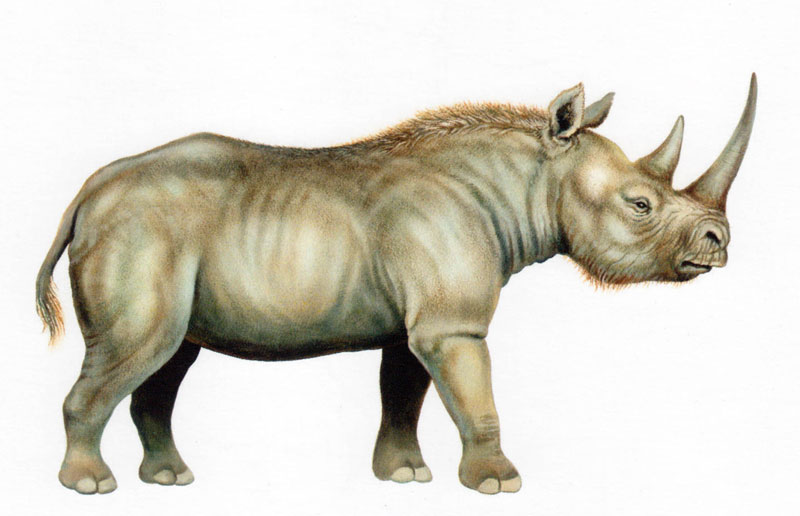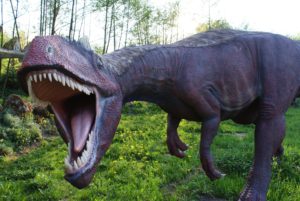Functions of the horns and frill [ edit ]
by Admin
Posted on 18-07-2023 09:48 AM

Triceratops ( /traɪˈsɛrətɒps/ try-serr-ə-tops ; lit. 'three-horned face') is a genus of chasmosaurine ceratopsian dinosaur that lived during the late maastrichtian age of the late cretaceous period , about 68 to 66 million years ago in what is now western north america. It was one of the last-known non-avian dinosaurs and lived until the cretaceous–paleogene extinction event 66 million years ago.
 The name triceratops, which literally
means
'three-horned face', is derived from the greek words trí- ( τρί- ) meaning 'three', kéras ( κέρας ) meaning 'horn', and ṓps ( ὤψ ) meaning 'face'. Bearing a large bony frill , three horns on the skull, and a large, four-legged body, exhibiting convergent evolution with bovines and rhinoceroses, triceratops is one of the most recognizable of all dinosaurs and the most well-known ceratopsian.
The name triceratops, which literally
means
'three-horned face', is derived from the greek words trí- ( τρί- ) meaning 'three', kéras ( κέρας ) meaning 'horn', and ṓps ( ὤψ ) meaning 'face'. Bearing a large bony frill , three horns on the skull, and a large, four-legged body, exhibiting convergent evolution with bovines and rhinoceroses, triceratops is one of the most recognizable of all dinosaurs and the most well-known ceratopsian.
Torosaurus as growth stage of Triceratops [ edit ]
The skull is known to have undergone dramatic changes in shape throughout the development of triceratops from an embryo to an adult. The smallest triceratops skulls have small straight horns above their eyes.
 Slightly larger juvenile specimens have backward-curving horns above the eyes and triangular epoccipitals bordering the large frill at the back of the skull. As juveniles matured into adults, their horns curved forward and the epoccipitals bordering the frill became flattened. Triceratops is thought to have lived alongside another large horned dinosaur, torosaurus , which is distinguished from triceratops by its larger, thinner cranial frill that is perforated by two large openings.
Slightly larger juvenile specimens have backward-curving horns above the eyes and triangular epoccipitals bordering the large frill at the back of the skull. As juveniles matured into adults, their horns curved forward and the epoccipitals bordering the frill became flattened. Triceratops is thought to have lived alongside another large horned dinosaur, torosaurus , which is distinguished from triceratops by its larger, thinner cranial frill that is perforated by two large openings.
2. Dinozaury jak ssaki, bo stałocieplne
Prawdziwym przewrotem naukowym było odkrycie z lat 60. Xx wieku udowadniające, że wymarłe dinozaury były w przeciwieństwie do współczesnych gadów stałocieplne. Ponadto wykazywały się one szybką przemianą materii i prowadziły aktywny tryb życia. Stałocieplne są dzisiaj m. In. Ssaki oraz ptaki, które wyewoluowały od wspólnego przodka z dinozaurami. Czytaj też: jak współcześnie wyglądałyby dinozaury?.
Is it a dinosaur?
Wędrówki z dinozaurami ( ang. Walking with dinosaurs) – paradokumentalny serial telewizyjny , wyprodukowany przez telewizję bbc i po raz pierwszy emitowany w wielkiej brytanii w 1999 r. , z kennethem branaghem jako narratorem. W polsce serial był po raz pierwszy emitowany w roku 2000 w programie drugim telewizji polskiej ; konsultantem naukowym wersji polskiej był karol sabath , a lektorami – maciej gudowski i janusz szydłowski. Stylizowane na dokument przyrodniczy, wędrówki z dinozaurami przy użyciu komputerowych efektów specjalnych i animatroniki starają się odtworzyć wygląd i zachowania dinozaurów i innych zwierząt z ery mezozoicznej. W odróżnieniu od wielu starszych filmów dokumentalnych poświęconych dinozaurom, przeznaczających stosunkowo niewiele czasu na sceny ze zrekonstruowanymi zwierzętami, wędrówki z dinozaurami niemal całkowicie skupiają się na pokazywaniu scen z życia prehistorycznych zwierząt, ich zachowań, interakcji z otoczeniem, relacji z przedstawicielami swojego i innych gatunków, zdobywania pożywienia, walki i rozmnażania; dane o tych aspektach ich życia uzyskano dzięki badaniom skamieniałości uzupełnionym przez spekulacje oparte na analizie zachowań współczesnych zwierząt.
Podobnie jak inne super długie dinozaury, superzaur jest dużym zauropodem z rodziny diplodoków (diplodocidae). Ma ekstremalnie długą szyję i dorównujący jej ogon. Uważa się, że żył około 150 milionów lat temu, w okresie jurajskim. Pierwsze szczątki superzaura odkryto w 1972 r. Na stanowisku archeologicznym znanym jako dry mesa dinosaur quarry, które autor nowego badania, dr brian curtice, paleontolog z muzeum historii naturalnej w arizonie, nazywa „sałatką z kości”. To żartobliwe określenie odnosi się do faktu, że wszystkie kości znajdowały się we wspólnym dole, a naukowcy początkowo nie potrafili stwierdzić, czy należą one do jednego zwierzęcia, kilku osobników tego samego gatunku, czy do przedstawicieli różnych gatunków.
Many other horned dinosaurs are known to have lived in herds because of a fossil find of many different individuals at the same location. By moving in herds, prey animals can warn each other of danger and lessen their chances of being singled out by a predator. However, triceratops was unusual in this respect, as their remains are usually found individually, suggesting they may have spent much of their lives alone.